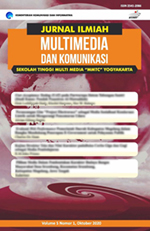Implementation of Fiber Optic Network in Media Production Studio Integration at STMM Yogyakarta
Abstract
Keywords
Full Text:
PDF (Bahasa Indonesia)References
Dai, M. (2020). Research on Networking Technology of Digital Terrestrial Television Single Frequency Network. 2020 International Wireless Communications and Mobile Computing, IWCMC 2020, 525–529. https://doi.org/10.1109/IWCMC48107.2020.9148264
Goff, D. (2020). Fiber Optic Fundamentals. In Fiber Optic Reference Guide. https://doi.org/10.4324/9780080506319-6
Hiraoka, Y. (2022). Development of Broadcast receiver for ultra-high-definition TV using RoF technology by GI-POF. Proceedings of SPIE - The International Society for Optical Engineering, 12025. https://doi.org/10.1117/12.2614530
Kaur, S., Singh, P., Tripathi, V., & Kaur, R. (2022). Recent trends in wireless and optical fiber communication. Global Transitions Proceedings, 3(1), 343–348. https://doi.org/10.1016/j.gltp.2022.03.022
Saglik, M., & Ozturk, S. (2001). Television as an Educational Technology: Using Television at Open Education Faculty, Anadolu University. Turkish Online Journal of Distance Education, 2(1), 74–82. https://doi.org/10.17718/tojde.13218
Sjøvaag, H., Olsen, R. K., & Ferrer-Conill, R. (2024). Delivering content: Modular broadcasting technology and the role of content delivery networks. Telecommunications Policy, 48(4). https://doi.org/10.1016/j.telpol.2024.102738
DOI: https://doi.org/10.56873/jimk.v10i1.482
Refbacks
- There are currently no refbacks.
Copyright of Jurnal Ilmiah Multimedia dan Komunikasi
Sekolah Tinggi Multi Media "MMTC" Yogyakarta
Jln. Magelang Km. 6 Yogyakarta | Telepon: (0274) 561531, 562513 | Fax: (0274) 623537 | Email : multkom@mmtc.ac.id
p-ISSN 2541-2086 | e-ISSN 2776-0006
 | Jurnal Ilmiah Multimedia dan Komunikasi is licensed under a Creative Commons Attribution-NonCommercial-ShareAlike 4.0 International License |










